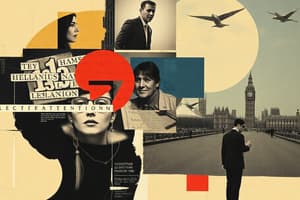Podcast
Questions and Answers
¿Qué ejemplo se muestra en la situación descrita en el texto?
¿Qué ejemplo se muestra en la situación descrita en el texto?
- Teoría del cocktail-party
- Pre-fijación de la atención
- Ley de la entrada prioritaria
- Set atencional (correct)
¿En qué consiste la predisposición mental mencionada en el texto?
¿En qué consiste la predisposición mental mencionada en el texto?
- Escuchar todos los sonidos del entorno
- Estar especialmente atento a la voz de un amigo (correct)
- Reconocer múltiples voces simultáneamente
- Ignorar por completo las distracciones
¿Cómo se facilita el reconocimiento rápido de la voz del amigo?
¿Cómo se facilita el reconocimiento rápido de la voz del amigo?
- Gracias al set atencional (correct)
- A través de la pre-fijación de la atención
- Por la teoría del cocktail-party
- Mediante la ley de la entrada prioritaria
¿Qué tipo de atención está mostrando María durante la conferencia?
¿Qué tipo de atención está mostrando María durante la conferencia?
¿Qué tipo de atención está demostrando Juan mientras juega con su teléfono en la sala de espera?
¿Qué tipo de atención está demostrando Juan mientras juega con su teléfono en la sala de espera?
¿Qué tipo de atención es descrita como mantener el foco en un estímulo o tarea durante un período prolongado de tiempo?
¿Qué tipo de atención es descrita como mantener el foco en un estímulo o tarea durante un período prolongado de tiempo?
¿Qué se entiende por 'set mental' en el contexto de la atención humana?
¿Qué se entiende por 'set mental' en el contexto de la atención humana?
Según la perspectiva histórica de 'la atención como acto motor', ¿cómo está vinculada la atención?
Según la perspectiva histórica de 'la atención como acto motor', ¿cómo está vinculada la atención?
¿En qué consiste la capacidad de 'atención dividida'?
¿En qué consiste la capacidad de 'atención dividida'?
¿Cuál estrategia utilizó Juan para enfocarse en el ruido del globo?
¿Cuál estrategia utilizó Juan para enfocarse en el ruido del globo?
¿Qué estrategia utilizó Luisa para escuchar específicamente la historia de su abuela?
¿Qué estrategia utilizó Luisa para escuchar específicamente la historia de su abuela?
¿Qué demostró Sara al poder montar en bicicleta sin concentrarse en los movimientos específicos?
¿Qué demostró Sara al poder montar en bicicleta sin concentrarse en los movimientos específicos?
¿Qué estrategia utilizó Juan para enfocarse en el ruido del globo?
¿Qué estrategia utilizó Juan para enfocarse en el ruido del globo?
¿Qué estrategia utilizó Luisa para escuchar específicamente la historia de su abuela?
¿Qué estrategia utilizó Luisa para escuchar específicamente la historia de su abuela?
¿Qué demostró Sara al poder montar en bicicleta sin concentrarse en los movimientos específicos?
¿Qué demostró Sara al poder montar en bicicleta sin concentrarse en los movimientos específicos?
Flashcards are hidden until you start studying
Study Notes
- Juan estaba leyendo un libro en una plaza when suddenly a loud noise distracted him.
- The noise came from a popped balloon nearby. Involuntary attention was the strategy Juan used to focus on the source of the noise.
- Luisa was in a family gathering and was trying to listen specifically to her grandmother's old story.
- She focused solely on her grandmother's voice and ignored other conversations, using top-down processing strategy.
- Sara had practiced biking for months and had reached a level where she could bike without concentrating on the specific movements.
- While pedaling, she would often think about other things or enjoy the scenery, demonstrating the cognitive process of automatization.
- Juan's involuntary attention was triggered by the unexpected and loud noise from the balloon.
- Luisa intentionally used the top-down processing strategy invoking her specific goal to listen to her grandmother's story.
- Sara's years of practice led her to the automatization of biking, allowing her to multitask mental activities while cycling.
In English:
- Juan was reading a book in a park when suddenly a loud noise interrupted him.
- The noise came from a popped balloon nearby, causing Juan to use the involuntary attention strategy to focus on the source.
- Luisa was in a family reunion and was trying to listen specifically to her grandmother's old story.
- She focused solely on her grandmother's voice and ignored other conversations, employing the top-down processing strategy.
- Sara had practiced biking for months and had reached a level where she could bike without focusing on the specific movements.
- While pedaling, she would often think about other things or enjoy the scenery, demonstrating the cognitive process of automatization.
- Juan's invulnerable attention was triggered by the unexpected and loud noise from the balloon.
- Luisa intentionally used the top-down processing strategy to achieve her goal of listening to her grandmother's story.
- Sara's consistent practice led her to the automatization of biking, allowing her to multitask mental activities while cycling.
Studying That Suits You
Use AI to generate personalized quizzes and flashcards to suit your learning preferences.



